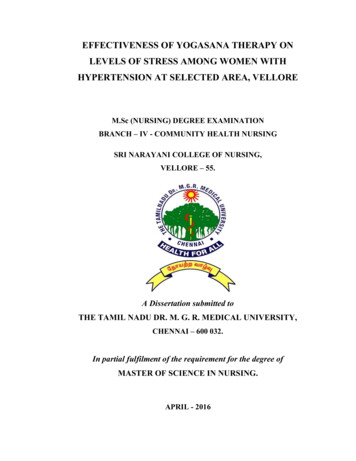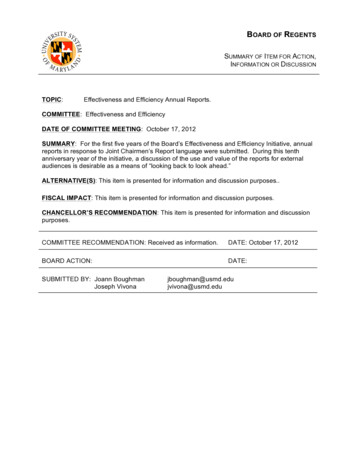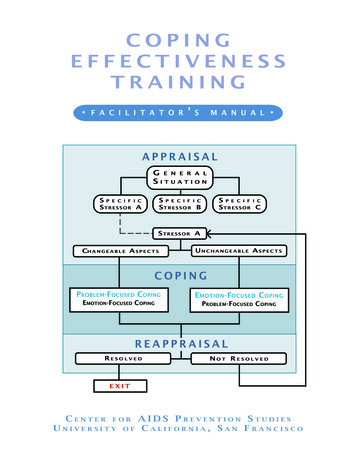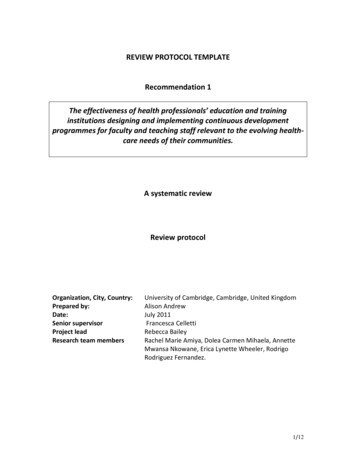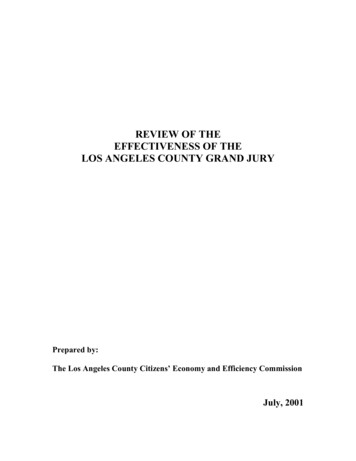
Transcription
REVIEW OF THEEFFECTIVENESS OF THELOS ANGELES COUNTY GRAND JURYPrepared by:The Los Angeles County Citizens’ Economy and Efficiency CommissionJuly, 2001
THE LOS ANGELES COUNTYCITIZENS’ ECONOMY AND EFFICIENCY COMMISSIONThe Los Angeles CountyCitizens’ Economy and Efficiency CommissionChairRobert H. PhilibosianVice ChairTony LucenteGrand Jury Task ForceJaclyn Tilley Hill, ChairClayton R. AndersonIsaac Diaz BarcelonaHope BoonshaftG. Thomas ThompsonCommissionersFred BalderramaJoanne BaltierrezAnnie E. ChoJohn CrowleyDavid FarrarJonathan S. FuhrmanChun Y. LeeRoyal F. OakesRoman PadillaWilliam J. PetakH. Randall StokeJulia SylvaTony TortoriceExecutive DirectorBruce J. StaniforthContributorJeanne KennedyThe purpose of the Commission is to examine anyfunction of county government at the request of theBoard of Supervisors, on its own initiative, or assuggested by others and adopted, and to submitrecommendations to the Board which will improve localgovernment economy and efficiency, and effectiveness.
July 12, 2001ChairmanHonorable Michael D. AntonovichMayor Los Angeles County and Chair of the Board of SupervisorsRoom 869, Kenneth Hahn Hall of Administration500 West Temple StreetLos Angeles, CA 90012Robert H. PhilibosianVice ChairTony LucenteCommissionersDear Mayor Antonovich:Clayton R. AndersonFred BalderramaAs you are aware, the Los Angeles County Superior Court bifurcated the2000-2001 Grand Jury into its criminal and civil functions. As a result ofthis bifurcation several problems arose that have required increasedattention by the court. These issues, involving items such as facilities,training, morale, ability to indict, costs, and recruitment, have causeddifficulties for both the court and the grand jury. Although the court hasalready addressed many of these issues, the Economy and EfficiencyCommission wished to further assist the court in their efforts and to raiseother specific concerns. Thus, the Commission undertook a review of thegrand jury to consider these difficulties in the context of the operationsand effectiveness of the separate functions that have been divided.Joanne BaltierrezIsaac Diaz BarcelonaHope J. BoonshaftAnnie E. ChoJohn CrowleyDavid FarrarJonathan S. FuhrmanJaclyn Tilley HillChun Y. LeeRoyal F. OakesRoman PadillaWilliam J. PetakH. Randall StokeJulia SylvaG. Thomas ThompsonTony TortoriceExecutive DirectorBruce J. StaniforthThe accompanying report makes several recommendations that addressboth immediate term considerations that are intended to improve theoperations of the existing grand jury and a longer-term recommendationinvolving the structure of the grand jury. Some of these recommendationsare addressed to county departments and some are intended to assist thecourt and the grand jury in fulfilling their responsibilities to the residentsof Los Angeles County.As always, the Commission remains available to contribute in anywaypossible and looks forward to working with the Board, the court and thegrand jury to assist the grand jury in whatever way is deemed appropriate.Sincerely,Robert H. PhilibosianChairmanC: Each SupervisorKenneth Hahn Hall of Administration, 500 West Temple Street, Suite 163, Los Angeles, CA 90012-2713(213) 974-1491 FAX (213) 620-1437 E-mail: eecomm@co.la.ca.us Web Site: http://eec.co.la.ca.us
SPECIAL ACKNOWLEDGEMENTTHE CITIZENS’ ECONOMY AND EFFICIENCY COMMISSIONWOULD LIKE TO APPLAUD THE COOPERATIVE EFFORTS OFTHE JUSTICE SYSTEM AND THE ADMINISTRATIVE SYSTEMOF LOS ANGELES COUNTY.IN MEMORIUMHONORABLE STEPHEN E. O’NEILJUDGE OF THE SUPERIOR COURT, (1945-2001)THE CITIZENS’ ECONOMY AND EFFICIENCY COMMISSIONWISHES TO ACKNOWLEDGE THE VALUE AND INSIGHTPROVIDED BY JUDGE O’NEIL TO THECOMMISSION AND ITS MEMBERSTHROUGHOUT THE YEAR.“COMMITMENT IS WHAT TRANSFORMS A PROMISE INTO REALITY.”ABRAHAM LINCOLN
REVIEW OF THE EFFECTIVENESS OF THE LOS ANGELESCOUNTY GRAND JURYTABLE OF CONTENTSEXECUTIVE SUMMARY1INTRODUCTION5SCOPE OF THE STUDY6GRAND JURY CIVIL OVERSIGHT6Legal AuthorityOrganization of the Los Angeles County Civil Grand JuryThe Grand Jury Civil FunctionANALYSIS OF PREVIOUS RECOMMENDATIONSOverviewRequirements in Responding to Grand Jury RecommendationsFormat for County Reporting of Recommendation StatusTable I, Implementation Status of Grand Jury RecommendationsAnalysis of Reported Implementation Status6889910111112ANALYSIS OF ORGANIZATIONS EXAMINED16AVAILABILITY OF RESOURCES17Table 2, Grand Jury Seven Year Budget SummaryINTERMEDIATE TERM CONSIDERATIONSGrand Juror RecruitmentTerm of Service of the Grand JuryAuthority to Conduct Criminal InvestigationsNeed for TrainingCoordination with the Economy and Efficiency Commission18181820212225OTHER COUNTY GRAND JURY MODELS25GRAND JURY MODEL27Considerations in Model DevelopmentRecommended Grand Jury ModelCONCLUSIONAPPENDICES I & II272930
EXECUTIVE SUMMARYPrimarily in an attempt to respond to concerns raised regarding the diversity of the grandjury, the Los Angeles County Superior Court bifurcated the 2000-2001 Grand Jury intoits criminal and civil functions. As a result of this bifurcation several problems arose thatrequired increased attention by both the court and the grand jury. These problemsincluded facilities management, training, morale, ability to indict, costs and recruitment.To assist the court in their efforts and in response several specific concerns, the Economyand Efficiency Commission undertook a review of the grand jury to consider thesedifficulties in the context of the operations and effectiveness of the separate functionsinto which it has been divided.In the course of this review, the Commission found several areas in which improvementscould be achieved. The areas that were identified included:(a) the need for the county to give increased attention to grand juryrecommendations to provide effective monitoring and follow-up;(b) the numerous instances within the grand jury report format andapproach, which could be improved to assist agencies and jurisdictionsin the implementation of recommendations;(c) the determination that some departments were reviewed very often,while others had not been reviewed for some time; and,(c) the potential for improvement in both the organizational structure andoperational components of the grand jury that would meaningfullycontribute to the organization’s success.The analysis conducted in the course of this review was used as a basis for developing therecommendations that are presented below. The majority of these recommendationsaddress issues that can be accomplished in the near to intermediate term to facilitate theoperations of the existing 2001-2002 bifurcated Grand Jury. In the longer term, theCommission is recommending a return to the one grand jury model for reasons that arepresented in the body of the report. The Commission believes that it is possible toreinstitute the single grand jury system during the 2001-2002 Grand Jury session.ECONOMY & EFFICIENCY COMMISSION RECOMMENDATIONS1. Direct the Auditor-Controller to provide departments responding to grand juryrecommendations with a standard format that complies with the requirements of theCalifornia Penal Code.2. Direct the Auditor-Controller to insure that the county responses are submitted in amanner that enables the reader to clearly identify the actions that are taken, or not taken,on a particular recommendation, together with the value to be gained through itsimplementation.Page 1 of 30
3. That the grand jury could become increasingly effective in its recommendationprocess by considering the potential impacts of its recommendations on the agency itexamines (e.g. costs, personnel, etc.).4. That the grand jury consider, within the course of its investigations, identifying thoseareas that it considers to be particularly effective in managing or operating a program.This approach would enable an agency to capitalize upon the benefits that could beaccrued and to provide other departments and agencies with the possibility ofimplementing a similar approach to also achieve these benefits. It should be explainedduring grand jury instructions that expanding upon excellent business practices can oftensave as much money in correcting problem areas.5. Direct the Chief Administrative Officer to enter into an agreement with the grand jury,either through contract or through employee assignment, to provide a policy/operationaladvisor to assist in understanding the structure of the county. This governmentalpolicy/operations advisor should be familiar with government programs and operations,have experience in program evaluations, the planning/conduct of studies andprofessional audits. The position would function in an advisory role that is similar tothat of the current legal advisor.6. That the grand jury give consideration to establishing a grand jury report format andan official agency comment process and follow-up reporting. This would provide forconsistency that promotes a comprehensive response to civil grand jury report findingsand recommendations. In the creation of a style guide the grand jury should consider aformat that will facilitate the agency’s response. This process could incorporate the useof an electronic copy of the report to encourage effective responses from agencies.7. That it would be more effective for the grand jury recommendations to be directed tooperating departments when the recommendations are operational. Recommendationsshould only be directed to the Board of Supervisors in those instances where the Boardhas responsibility, e.g. budget, personnel.8. That the grand jury insure that the recommendations are clearly stated with theobjective of precluding the possibility for misinterpretation or an unclear or inaccurateresponse from the department. For example, to “urge” action does not provide adepartment/agency with adequate direction. Specific direction would be more helpfuland would insure that the intent of the recommendation was understood.9. That the grand jury insures that in the development of recommendations for theCounty that they consider any controlling legislation that may restrict or prohibit theimplementation of a recommendation. In these instances, the recommendation should beto propose a change in the legislation.Page 2 of 30
10. That the grand jury develops a list of study priorities that identifies those areas thatwere considered for study, but either as a result of time or resource constraints, theywere unable to undertake. This information would then be provided to the incominggrand jury to be used as an additional tool in the development of their work plan.11. That the grand jury develop a “schedule of past audits” which informs incominggrand juries of those departments, organizations, jurisdictions, or functions that havebeen examined, the length of time since the last investigation of each revieweddepartment, organization, jurisdiction, or function, and the major recommendations as aresult of any investigation.12. That the grand jury creates an historical, electronic, and searchable file that willallow an incoming grand jury to easily review the work, recommendations, and conduct,where deemed appropriate, follow-up of previous recommendations and agencyresponses.13. That the grand jury/courts establish an ongoing speakers bureau to provide for thecontinual distribution of information on grand jury service and issues.14. That the jury commissioner, through the use of a paid or unpaid advisor, continuesefforts to develop an outreach plan that will insure an effective means by which thepublic can be informed of grand jury service. This plan should be designed to reachevery area and segment of Los Angeles County society.15. That the jury commissioner improves the access to the grand jury for the residents ofLos Angeles County. This access would enable residents to gain additional informationor to enable them to submit a citizen complaint.16. Direct the Chief Administrative Officer to provide for increased input by the grandjury in the development of the grand jury budget.17. That the jury commissioner conduct a training session with the members of the grandjury pool to assist them in further understanding the responsibilities that they are aboutto undertake and to enable them to quickly become more effective if selected.18. The instructions for the civil grand jury should:(a) Include an explanation of the purpose and functioning of the civil grand jury,an explanation of how local government functions, and methodologies that wouldprovide the grand jury with the means to examine local government policies andoperations.(b) Emphasize in any instruction that jurors utilize the resources available tothem to review issues for relevance and propriety, have factual questionsanswered by governmental organizations; and, if necessary, ask appropriatequestions of agency officials.Page 3 of 30
19. The Unified Court System should:(a) Develop a comprehensive training program for grand jurors that will addressthe needs of the new members of the grand jury. Such training should include ata minimum, committee work, successful meeting management, conducting audits,developing research design, interviewing techniques, examining documents andanalyzing data.(b) Prepare a Civil Grand Juror's Handbook that explains the responsibilities ofgrand jurors. The handbook should be written in layperson terms and cover theadministration of the grand jury system, the purpose, and the functioning of thecivil grand jury.(c) The Unified Court System should consider acquiring or producing a civilgrand juror orientation film.(d) The Court Administrator should conduct a pilot project to evaluate thefeasibility of providing the initial orientation material during the summoningprocess.(e) A task force should be appointed, perhaps composed of former grand jurors,to review the civil instructions given to grand jurors during their orientation todetermine if the presentation can be made clearer for the jurors. Thisexamination should review what information should be given to jurors, when itshould be given, and by whom.(f) The grand jury foreperson should be given additional instructions from thecourt as to their role and responsibilities.20. That the Superior Court return as soon as possible to the one panel grand jury model.The Economy and Efficiency Commission believes that it is possible to reinstitute thesingle grand jury system during the 2001-2002 session.Page 4 of 30
REVIEW OF THE EFFECTIVENESSOF THE LOS ANGELES COUNTY GRAND JURYINTRODUCTIONIn one form or another, the concept of a grand jury has existed in western law for morethan 800 years. It has been considered to be such a fundamental right that it wasincorporated within the United States Bill of Rights. The most fundamental purposes ofthis institution are to protect and defend the freedoms provided to the residents of theUnited States and, as importantly, to provide a mechanism to limit the power ofgovernment. In recognition of the importance of these purposes the courts and theCongress have historically defended the grand jury system and its ability to bring anindictment against any interference with its structure or operations.Even though the objectives of the grand jury are fundamental and critical to the operationof a democratic government, the grand jury system, as it had been structured within LosAngeles County, has not been without its critics. These critics have claimed that theinstitution has not been reflective of the population and, as a result, can no longer beeffective in accomplishing all the purposes for which it was established. Theimplications of this argument result in the contention that the grand jury was being usedas tool of prosecutors and, by inference, as a means of government oppression. Althoughnone of these challenges have been upheld, the Superior Court of Los Angeles Countydecided that beginning with the 2000-01 session the grand jury would be bifurcate into itscriminal and civil oversight functions. The action of splitting these functions has resultedin the implementation of a grand juror selection process that appears to be responsive tothe diversity issue. As a result, this organizational approach has enabled the court toaddress these concerns and eliminate them as a basis for a constitutional challenge.The creation of a bifurcated system, while addressing the diversity issue, has createdother difficulties that required attention to insure that the fundamental purposes for theexistence of a grand jury were being fulfilled. For example those indictments sought bythe District Attorney that require extensive investigation and review (i.e. BelmontLearning Center or the ongoing Rampart investigation) will require some form oforganizational accommodation under the bifurcated structure. Clearly, such an extensiveinvestigative commitment is not consistent with the current 30-day term of the criminalgrand jury, nor is it possible within either the present structure or oversightresponsibilities of the civil grand jury.As a result of the court’s action to bifurcate the grand jury and the consequences of thisaction on other law and justice departments within the county, it is both reasonable andappropriate to raise some fundamental questions regarding the effectiveness of this actionand to consider how this action has impacted the accomplishment of the purposes forwhich the grand jury has been created.Page 5 of 30
SCOPE OF THE STUDYThe Economy and Efficiency Commission recognizes that:“The grand jury is an instrumentality of the courts of this state, and assuch is charged with a quasi judicial inquisition into the conduct ofcitizens and of public institutions and officials, and it is to be as fullyprotected in the exercise of its powers and functions in that regard as thecourts themselves. Whatever, therefore, manifestly tends and is intendedto constitute an interference with the proper exercise of the duties andfunctions of a grand jury while engaged in the consideration of suchmatters as may properly come before it would obviously amount to acontempt of court.”1This review is not intended to constitute any interference in the actions taken or proposedby either the court or the grand jury, but is rather intended to assist, in an advisorycapacity, in improving the efficiency and effectiveness of the grand jury. To date, mostof the research on grand juries has focused on the exercise of its criminal responsibilities,with little attention given to how well it functions in carrying out its civil oversightfunction. The bifurcation of the grand jury facilitates both the independent considerationof the two functions and how the current structure responds to the requirements of thecourts, the law and justice agencies, the county, and the residents of Los Angeles County.To accomplish the objectives of this review, the Grand Jury Task Force of the Economyand Efficiency Commission conducted interviews with numerous individuals within thejustice system and the administrative system of Los Angeles County. The Task Forcealso undertook limited research into the operations and structural issues of theorganization with the purpose of establishing a basis for making recommendations toimprove the Grand Jury System within Los Angeles County.GRAND JURY CIVIL OVERSIGHTLegal AuthorityIn California the grand jury's oversight function, which is accountable for reviewing localgovernmental operations, has a long and respected history. As early as 1880, the StateLegislature assigned to the grand jury the responsibility of making “a careful andcomplete examination of the books, records and accounts of all offices of the county, andto report thereon.” Over the years, the Legislature has expanded the grand jury'soversight responsibilities even further.1In re Shuler (1930) 210 Cal. 377, 292 P. 481.Page 6 of 30
California courts have repeatedly recognized the unique and invaluable role a grand juryfulfills in carrying out its oversight duties. In 1971, a Ca
Tony Lucente Grand Jury Task Force Jaclyn Tilley Hill, Chair Clayton R. Anderson Isaac Diaz Barcelona . the Los Angeles County Superior Court bifurcated the 2000-2001 Grand Jury into its criminal and civil functions. As a result of . Format for C




